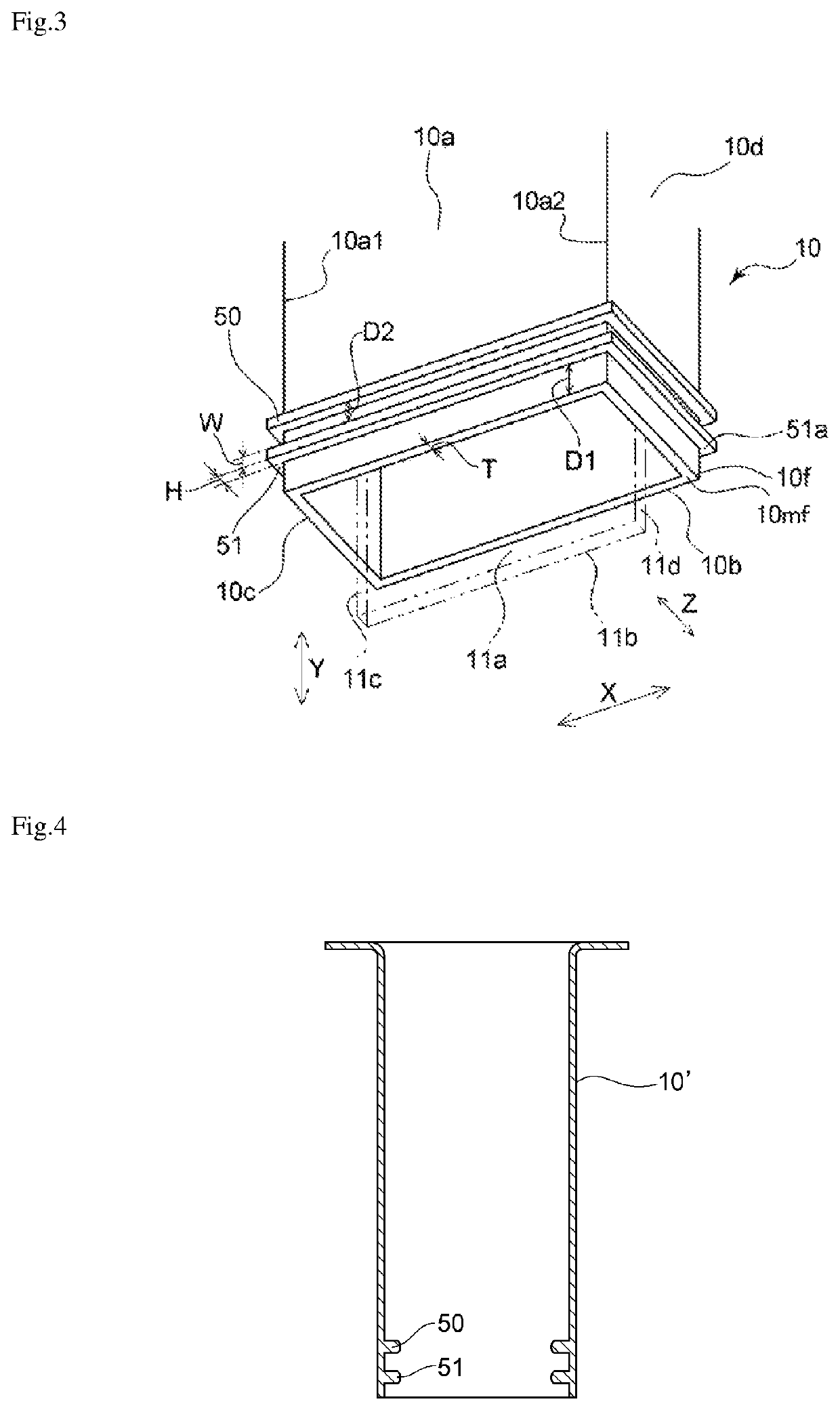Electrolytic cell for producing nitrogen trifluoride gas and partition therefor
a technology of electrolysis cell and nitrogen trifluoride, which is applied in the direction of electrolysis process, electrolysis components, organic diaphragms, etc., can solve the problems of resin partition plate deformation, and corrosion of reinforcing nickel plates, so as to eliminate the risk of corrosion, effectively suppress the deformation of partition, and operate stably
- Summary
- Abstract
- Description
- Claims
- Application Information
AI Technical Summary
Benefits of technology
Problems solved by technology
Method used
Image
Examples
example 1
[0072]The electrolytic cell shown in FIGS. 1 to 3 was used to produce nitrogen trifluoride. A partition of the embodiment shown in FIGS. 1 to 3 was obtained by integrally molding a polytetrafluoroethylene (PTFE) resin and was used as the partition in the electrolytic cell. The ratio (H / T) of the height H of each rib to the thickness T of the partition was 1.5. The ratio (W / T) of the width W of each rib to the thickness T of the partition 10 was 1. The ratio (D1 / T) of the distance D1 between the lower end position 51a of the rib 51 located the nearest to the lower end 10mf, of the ribs and the lower end 10mf of the partition to the thickness T of the partition 10 was 1. The ratio (D2 / T) of the inter-rib distance D2 to the thickness T of the partition was 1. Pure nickel with a purity of 99 mass % was used as each of the anode and the cathode. An ammonium fluoride-hydrogen fluoride molten salt NH4F.1.8HF was prepared from ammonia and anhydrous hydrofluoric acid in the electrolytic cell...
example 2
[0073]A similar procedure to that of Example 1 was performed except that the shape of the partition was changed to the shape (D1 / T=0, the number of ribs was three) shown in FIG. 5. A gas chromatography analysis was performed during the electrolysis, and contamination of the anode gas with hydrogen gas and contamination of the cathode gas with nitrogen trifluoride gas were not observed. Moreover, the partition plate after an operating time of three months had a shape similar to the shape thereof at the start of the operation, without deformation and the like, and was able to be reused in an electrolytic cell for producing nitrogen trifluoride gas.
example 3
[0074]A similar procedure to that of Example 1 was performed except that the material of the partition was changed to perfluoroalkoxy alkane (PFA). A gas chromatography analysis was performed during the electrolysis, and contamination of the anode gas with hydrogen gas and contamination of the cathode gas with nitrogen trifluoride gas were not observed. Moreover, the partition plate after an operating time of three months had a shape similar to the shape thereof after the operation, without deformation and the like, and was able to be reused in an electrolytic cell for producing nitrogen trifluoride gas.
PUM
| Property | Measurement | Unit |
|---|---|---|
| angle | aaaaa | aaaaa |
| angle | aaaaa | aaaaa |
| molar ratio | aaaaa | aaaaa |
Abstract
Description
Claims
Application Information
 Login to View More
Login to View More - R&D
- Intellectual Property
- Life Sciences
- Materials
- Tech Scout
- Unparalleled Data Quality
- Higher Quality Content
- 60% Fewer Hallucinations
Browse by: Latest US Patents, China's latest patents, Technical Efficacy Thesaurus, Application Domain, Technology Topic, Popular Technical Reports.
© 2025 PatSnap. All rights reserved.Legal|Privacy policy|Modern Slavery Act Transparency Statement|Sitemap|About US| Contact US: help@patsnap.com



